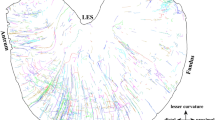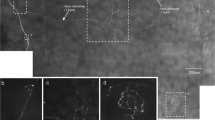Abstract
We have compared the three-dimensional (3D) morphology of stubby and spiny neurons derived from the human small intestine. After immunohistochemical triple staining for leu-enkephalin (ENK), vasoactive intestinal peptide (VIP) and neurofilament (NF), neurons were selected and scanned based on their immunoreactivity, whether ENK (stubby) or VIP (spiny). For the 3D reconstruction, we focused on confocal data pre-processing with intensity drop correction, non-blind deconvolution, an additional compression procedure in z-direction, and optimizing segmentation reliability. 3D Slicer software enabled a semi-automated segmentation based on an objective threshold (interrater and intrarater reliability, both 0.99). We found that most dendrites of stubby neurons emerged only from the somal circumference, whereas in spiny neurons, they also emerged from the luminal somal surface. In most neurons, the nucleus was positioned abluminally in its soma. The volumes of spiny neurons were significantly larger than those of stubby neurons (total mean of stubbies 806 ± 128 μm3, of spinies 2,316 ± 545 μm3), and spiny neurons had more dendrites (26.3 vs. 11.3). The ratios of somal versus dendritic volumes were 1:1.2 in spiny and 1:0.3 in stubby neurons. In conclusion, 3D reconstruction revealed new differences between stubby and spiny neurons and allowed estimations of volumetric data of these neuron populations.







Similar content being viewed by others
References
Anderson RL, Jobling P, Gibbins IL (2001) Development of electrophysiological and morphological diversity in autonomic neurons. J Neurophysiol 86:1237–1251
Anderson JR, Wilcox MJ, Wade PR, Barrett SF (2003) Segmentation and 3D reconstruction of biological cells from serial slice images. Biomed Sci Instrum 39:117–122
Braissant O (2007) Neurofilament proteins in brain diseases. In: Arlen RK (ed) New research on neurofilament proteins. Nova Science Publishers, New York, pp 25–51
Brandt R (2001) Cytoskeletal mechanisms of neuronal degeneration. Cell Tissue Res 305:255–265
Brandt R (2002) Increasing image fidelity with amiraDECONV™. Amira 3.0 www.amiravis.com
Brehmer A (2006) Structure of enteric neurons. Adv Anat Embryol Cell Biol 186:1–94
Brehmer A, Blaser B, Seitz G, Schrödl F, Neuhuber W (2004a) Pattern of lipofuscin pigmentation in nitrergic and non-nitrergic, neurofilament immunoreactive myenteric neuron types of human small intestine. Histochem Cell Biol 121:13–20
Brehmer A, Croner R, Dimmler A, Papadopoulos T, Schrödl F, Neuhuber W (2004b) Immunohistochemical characterization of putative primary afferent (sensory) myenteric neurons in human small intestine. Auton Neurosci 112:49–59
Brehmer A, Lindig TM, Schrodl F, Neuhuber W, Ditterich D, Rexer M, Rupprecht H (2005) Morphology of enkephalin-immunoreactive myenteric neurons in the human gut. Histochem Cell Biol 123:131–138
Brehmer A, Schrödl F, Neuhuber W (2006) Morphology of VIP/nNOS-immunoreactive myenteric neurons in the human gut. Histochem Cell Biol 125:557–565
Dogiel AS (1899) Ueber den Bau der Ganglien in den Geflechten des Darmes und der Gallenblase des Menschen und der Säugethiere. Arch Anat Physiol Anat Abt (Leipzig) 130–158
Eaker EY (1997) Neurofilament and intermediate filament immunoreactivity in human intestinal myenteric neurons. Dig Dis Sci 42:1926–1932
Ermilov LG, Miller SM, Schmalz PF, Hanani M, Szurszewski JH (2000) The three-dimensional structure of neurons in the guinea pig inferior mesenteric and pelvic hypogastric ganglia. Auton Neurosci 83:116–126
Ermilov LG, Miller SM, Schmalz PF, Hanani M, Lennon VA, Szurszewski JH (2003) Morphological characteristics and immunohistochemical detection of nicotinic acetylcholine receptors on intestinofugal afferent neurones in guinea-pig colon. Neurogastroenterol Motil 15:289–298
Ermilov LG, Schmalz PF, Miller SM, Szurszewski JH (2004) PACAP modulation of the colon-inferior mesenteric ganglion reflex in the guinea pig. J Physiol 560:231–247
Gabella G (1990) On the plasticity of form and structure of enteric ganglia. J Auton Nerv Syst 30:S59–S66
Ganns D, Schrodl F, Neuhuber W, Brehmer A (2006) Investigation of general and cytoskeletal markers to estimate numbers and proportions of neurons in the human intestine. Histol Histopathol 21:41–51
Gibbins IL, Teo EH, Jobling P, Morris JL (2003) Synaptic density, convergence, and dendritic complexity of prevertebral sympathetic neurons. J Comp Neurol 455:285–298
Hanani M, Ermilov LG, Schmalz PF, Louzon V, Miller SM, Szurszewski JH (1998) The three-dimensional structure of myenteric neurons in the guinea-pig ileum. J Auton Nerv Syst 71:1–9
Holmes TJ, Bhattacharyya S, Cooper JA, Hanzel D, Krishnamurthi V, Lin W, Roysam B, Szarowski DH, Turner JN (1995) Light microscopic images reconstructed by maximum likelihood deconvolution. In: Pawley JB (ed) Handbook of biological confocal microscopy. Plenum, New York, pp 389–402
Jobling P, Gibbins IL, Morris JL (2003) Functional organization of vasodilator neurons in pelvic ganglia of female guinea pigs: comparison with uterine motor neurons. J Comp Neurol 459:223–241
Julien JP (1999) Neurofilament functions in health and disease. Curr Opin Neurobiol 9:554–560
Klockgether T, Skalej M, Wedekind D, Luft AR, Welte D, Schulz JB, Abele M, Burk K, Laccone F, Brice A, Dichgans J (1998) Autosomal dominant cerebellar ataxia type I. MRI-based volumetry of posterior fossa structures and basal ganglia in spinocerebellar ataxia types 1, 2 and 3. Brain 121:1687–1693
Liu Q, Xie F, Siedlak SL, Nunomura A, Honda K, Moreira PI, Zhua X, Smith MA, Perry G (2004) Neurofilament proteins in neurodegenerative diseases. Cell Mol Life Sci 61:3057–3075
Luft AR, Skalej M, Welte D, Kolb R, Burk K, Schulz JB, Klockgether T, Voigt K (1998) A new semiautomated, three-dimensional technique allowing precise quantification of total and regional cerebellar volume using MRI. Magn Reson Med 40:143–151
Luft AR, Skalej M, Schulz JB, Welte D, Kolb R, Burk K, Klockgether T, Voigt K (1999) Patterns of age-related shrinkage in cerebellum and brainstem observed in vivo using three-dimensional MRI volumetry. Cereb Cortex 9:712–721
Miller SM, Hanani M, Kuntz SM, Schmalz PF, Szurszewski JH (1996) Light, electron, and confocal microscopic study of the mouse superior mesenteric ganglion. J Comp Neurol 365:427–444
Okugawa G, Takase K, Nobuhara K, Yoshida T, Minami T, Tamagaki C, Magnotta VA, Andreasen NC, Kinoshita T (2003) Inter- and intraoperator reliability of brain tissue measures using magnetic resonance imaging. Eur Arch Psychiatry Clin Neurosci 253:301–306
Pieper S, Halle M, Kikinis R (2004) 3D slicer. Proceedings of IEEE international symposium on biomedical imaging: from nano to macro 2004. pp 632–635 (SPL technical report #448)
Pompolo S, Furness JB (1990) Ultrastructure and synaptology of neurons immunoreactive for gamma-aminobutyric acid in the myenteric plexus of the guinea pig small intestine. J Neurocytol 19:539–549
Ramón y Cajal S (1911) Histologie du systéme nerveux de l′homme et des vertébrés. Maloine, Paris
Rich A, Hanani M, Ermilov LG, Malysz J, Belzer V, Szurszewski JH, Farrugia G (2002) Physiological study of interstitial cells of Cajal identified by vital staining. Neurogastroenterol Motil 14:189–196
Schnell SA, Staines WA, Wessendorf MW (1999) Reduction of lipofuscin-like autofluorescence in fluorescently labeled tissue. J Histochem Cytochem 47:719–730
Stach W (1989) A revised morphological classification of neurons in the enteric nervous system. In: Singer MV, Goebell H (eds) Nerves and the gastrointestinal tract. Kluwer, Lancaster, pp 29–45
Stach W, Krammer H-J, Brehmer A (2000) Structural organization of enteric nerve cells in large mammals including man. In: Krammer H-J, Singer MV (eds) Neurogastroenterology from the basics to the clinics. Kluwer, Dordrecht, pp 3–20
Szurszewski JH, Ermilov LG, Miller SM (2002) Prevertebral ganglia and intestinofugal afferent neurones. Gut 51(suppl 1):i6–i10
Turner JN, Ancin H, Becker DE, Szarowski DH, Holmes M, O’Connor N, Wang M, Holmes T, Roysam B (1997) Automated image analysis technologies for biological 3D light microscopy. Int J Imag Syst Tech 8:240–254
Turner JN, Shain W, Szarowski DH, Lasek S, Dowell N, Sipple B, Can A, Al-Kofahi K, Roysam B (2000) Three-dimensional light microscopy: observation of thick objects. J Histotechnol 23:205–217
Vickers JC, Costa M (1992) The neurofilament triplet is present in distinct subpopulations of neurons in the central nervous system of the guinea-pig. Neuroscience 49:73–100
Watkins TW, Keast JR (1999) Androgen-sensitive preganglionic neurons innervate the male rat pelvic ganglion. Neuroscience 93:1147–1157
Weaver CM, Hof FR, Wearne SL, Lindquist WB (2004) Automated algorithms for multiscale morphometry of neuronal dendrites. Neural Comput 16:1353–1383
Yuan A (2007) Neurofilament protein partnership, export, transport, phosphorylation and neurodegeneration. In: Arlen RK (ed) New research on neurofilament proteins. Nova Science Publishers, New York, pp 53–79
Yushkevich PA, Piven J, Hazlett HC, Smith RG, Ho S, Gee JC, Gerig G (2006) User-guided 3D active contour segmentation of anatomical structures: significantly improved efficiency and reliability. Neuroimage 31:1116–1128
Acknowledgments
The excellent technical assistance of Karin Löschner, Stephanie Link, Andrea Hilpert, Hedwig Symowski and Inge Zimmermann (all Erlangen) is gratefully acknowledged. We thank the Department of Molecular Plant Physiology (Erlangen) for helping with the deconvolution. We thank Mark Anderson (Boston), Ian Gibbins (Adelaide) and Christian Lauterbach (Erlangen) for their advice and feedback and Katie Mastrogiacomo (Boston) for carefully reading the manuscript. The study was supported by Deutsche Forschungsgemeinschaft (BR 1815/3) and National Institutes of Health (P41 RR13218 and U54 EB005149).
Author information
Authors and Affiliations
Corresponding author
Rights and permissions
About this article
Cite this article
Lindig, T.M., Kumar, V., Kikinis, R. et al. Spiny versus stubby: 3D reconstruction of human myenteric (type I) neurons. Histochem Cell Biol 131, 1–12 (2009). https://doi.org/10.1007/s00418-008-0505-9
Accepted:
Published:
Issue Date:
DOI: https://doi.org/10.1007/s00418-008-0505-9




